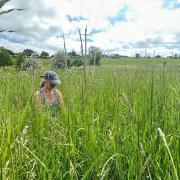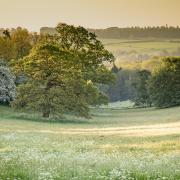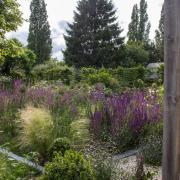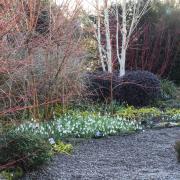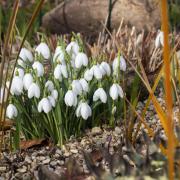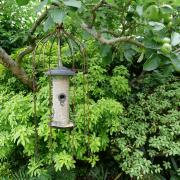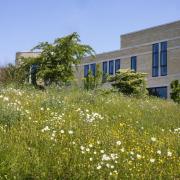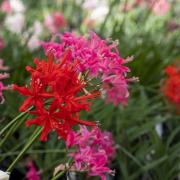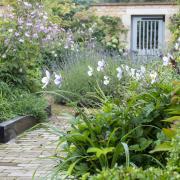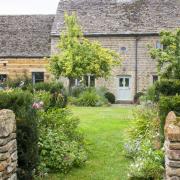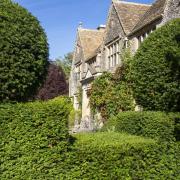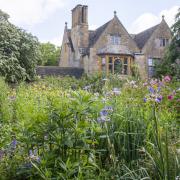As the Duchess of Cambridge prepares to unveil her RHS Back to Nature Garden at RHS Chelsea Flower Show later this month, Rachael Austin, Director and Landscape Architect at Austin Design Works in Gloucestershire, talks outdoor play and child-friendly gardens

A woodland setting, created as a space for families and communities to come together and connect with nature, is the hallmark of the RHS Back to Nature Garden co-designed by the Duchess of Cambridge.
Key elements of the Duchess' garden include logs for climbing a tree house and a stream, encouraging young visitors to make dams with stones and sand as a way of engaging with nature and attracting more wildlife to the site as established trees and shrubs combine to create a calming, habitat garden full of scent colour.
At Austin Design Works, the concept of natural play is one we've been championing through our landscape design for many years.
Government research shows children spend an average of just 68 minutes a day engaging in outdoor activity, and Sport England and the NHS are leading the charge to increase this dramatically to improve mental health among young people and reduce childhood obesity.
Here at ADW, creating 'play spaces' in their gardens is becoming as increasingly important as formal planting and hard landscaping.
It's why we were approached to lead a CPRE award-winning community playground project in Horsley village in Gloucestershire, which we designed and built following a six-year consultation and fundraising process.
Our brief was to create a new, creative, challenging and educational play space with play equipment for little ones and an environment attractive to older children.
The result - like the Duchess' garden - is a wonderfully inclusive garden like playground with a large sandpit, natural play logs, a willow tunnel, nut grove, wild flower area, insect hotels and dipping pond.
At Horsley, as with all the spaces we create, helping people connect with nature and appreciate wildlife in a beautiful space and spend quality time together in the great outdoors was our focus.

Studies show the benefits of outdoor play for children are immense.
The NCT (National Childbirth Trust) says playing outside is vital to children's physical and emotional development.
Research shows it helps them burn off energy and sleep better; improves confidence and gross motor skills and encourages the beginnings of a healthy lifestyle.
Here at ADW, we know how outdoor play has a positive impact on the whole family.
From better sleep patterns to becoming environmentally-aware at a young age, it's amazing how fresh air can blow away the cobwebs and improve mood.
Playing outside, whether on formal play structures or clambering on wobbly logs at Horsley, gives children the opportunity to use their whole body, boosting fitness and confidence.
It improves balance and helps them develop their gross motor skills.
And taking calculated risks - as Bear Grylls says, teaching children to do dangerous things safely - releases endorphins vital for positive mental health.
Plus the changing nature of wildlife areas makes them multi-sensory experiences, from the scent of blossom and birdsong in springtime to the feel of fallen leaves and the taste of wild blackberries in autumn, to the chill of the hoar frost on the grass in winter.
The whole village became engaged in this project, from toddler group and school sowing seeds, to youth club building bug hotels and bird boxes and experienced gardeners planting up the scheme.
Children are naturally drawn to playing outside, and the Horsley Playground has become a space for all ages to come together, to play, to chat, to picnic. All the community is seeing the benefit of this central resource and the village shop is thriving from the constant stream of families visiting to play.
As Sue Biggs, RHS Director General, says of the Chelsea Flower Show's Back to Nature Garden: "It's a beautiful, natural space for families to get together, play, dig, grow plants, connect with nature and spend time in the great outdoors."
It's what we set out to achieve in Horlsey, and, with the Duchess' garden about to be unveiled at the world's most famous flower show, long may this wild play trend continue.
Horsley Community Playground
ADW's community playground project, in the heart of Horsley in Gloucestershire, opened after six years of fundraising and consultation exercises to gauge support for the reinvention of the play area and to see what form it should take.
The conclusion of these detailed discussions was to create a new, creative, challenging and educative space with play equipment and an environment in which older children could engage in nature and play as much as little ones.
It also needed to act as a much-needed sociable community gathering place with seating, shade and picnic tables, to be shared with the village shop and other visitors.
Greenfields Ltd won the tender to contract the works and one of the first tasks was to tackle the waterlogged site by capturing seasonal flood water in a dipping pond, creating a habitat for frogs, toads and insects, alongside a space for muddy play.
Spoil was remodelled into a hill, contained on one side by a 3m retaining wall defining the kick-about area, topped with a play tower.
The old slide was reinstated and natural play logs formed a climbing structure and access to the top.
A zip wire, rope swing and monkey bars, supplied and installed by Playsafe and made from sustainable robinia hardwood, formed the main equipment attractions.
A large sand pit with huge logs for balance and sitting on, sourced from the neighbouring woodland, became essential natural play elements, all set within planting that includes a willow play structure and nut grove.
During the construction period, ADW ran a bug hotel-making workshop with the local youth club and helped with two community planting days, sowing wild flowers and constructing the willow tunnel and dome.
The playground is also a garden in the making and will continually be added to and enjoyed by the village for years to come.
The scheme, funded by The Veolia Environmental Trust, Gloucestershire Environmental Trust and Section 106 money from Horsley Parish Council, won a CPRE Gloucestershire award, recognising the quality, community engagement and vitality this project has brought to the centre of the village.
5 ways to build natural play into your garden:
Spaces don't have to be as big as Horsley to incorporate natural play and wildlife-friendly areas. Think of all the space those plastic slides, swings and trampolines take up in your garden. You can create a natural haven in the smallest of spaces to inspire imaginative play and a haven for adults and children alike.
1. Wobbling logs
Old tree stumps or large logs are perfect for children to balance on and can inspire a host of imaginative games.
2. Seating areas
Creating a dedicated seating or picnic area for children to retreat to encourages independence, conversation and creative play. Use old tree stumps topped with offcuts of wood from your shed for a rustic table surrounded by smaller stumps for seats.
3. Make a willow archway
Willow (Salix) is one of the most adaptable building materials. It's easy to create dens, archways and wigwams for children to play in. Plant whips from winter to early spring, in a naturally moist and sunny area, and bear in mind growth will double the height of the structure. The RHS website has some handy planting tips.
4. Build a bug hotel
Bug hotels don't just attract creepy-crawlies - they can become home to frogs, toads, newts, bees, dragonflies and damselflies too. Straw, dry grass and hollow plant stems, plentiful in autumn and winter, can be used in the construction to make hidey-holes for insects. Old wooden pallets, broken terracotta pots, bricks with holes in, old logs, spare roofing tiles and pine cones are all excellent material to stack together to create different habitats for different insects. The RSPB website has lots of ideas.
5. Plant a wild flower area
Manicured lawns aren't the best for bees and butterflies. Turning a corner of your garden into a magical, miniature wild flower area will attract all sorts of wildlife. The RHS sells meadow seed mix through its website, spring and autumn being the best time to plant. You may have to protect your newly-sewn area from hungry birds with a string of old CDs.
5 benefits of wild play gardens:
Like us at ADW, adventurer and Chief Scout Bear Grylls has long been urging children to put away their tablets and get outdoors to create their own adventures. NHS research shows a fewer than a quarter of children meet the minimum daily physical activity recommendations. School holidays and weekends are the ideal time to get off the sofa and into the garden. Here are the benefits…
1. Better sleep
Research shows fresh air and sunshine, plus burning all that excess energy, helps children and adults alike sleep better.
2. Great way to learn
Getting outdoors is a sensory experience, whatever your age. The changing seasons make gardens an incredibly stimulating and multi-sensory place to play. Since children learn through all their senses, it's vital. Using their whole body to play helps develop gross motor skills, and collecting seeds and pine cones helps fine motor skills.
3. Encourages a healthy lifestyle
Burning off excess energy and the mental stimulation which comes from playing outside encourages children to form healthy habits fo life - and that includes eating and sleeping. Government research shows spending time outdoors results in an improvement in physical and mental health and a reduction in child obesity. Sport England is also promoting outdoor play as an early entry into participatory sport.
4. Helps care for the environment
Being in a wild play area helps children connect with nature. Developing a respect for the natural environment, from identifying wildlife to understanding the growth cycle of plants and trees, getting children into the great outdoors is proven to help them become more environmentally-aware adults.
5. Positive impact on the whole family
Spending time in a space like Horsley Community Playground or the RHS Back to Nature Garden can make a world of difference to children's behaviour and how you feel as a parent. After sleepless nights or when your children are feeling grizzly, a couple of hours of challenging play and physical interaction can reset even the most frazzled mind.
To find out more about Austin Design Works, visit austindw.co.uk.




